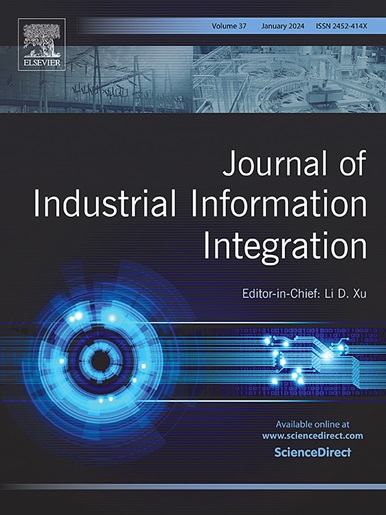氧化球团回转窑关键变量的工业数字孪生软测量
IF 10.4
1区 计算机科学
Q1 COMPUTER SCIENCE, INTERDISCIPLINARY APPLICATIONS
引用次数: 0
摘要
篦机-窑氧化球团工艺在炼铁过程中起着至关重要的作用,其高效运行对提高能源效率和环境绩效具有重要意义。然而,回转窑工艺的复杂性和其内部状态难以直接测量,限制了生产过程的监控和优化。数字孪生技术作为工业4.0工业物联网的关键使能器,可以创建物理实体的虚拟副本,实现虚拟与真实系统的交互和实时监控,从而为智能回转窑的智能驱动优化提供创新解决方案。在此背景下,本研究构建了回转窑数字孪生系统,该系统集成了三维温度场仿真模型、壁厚监测模型和降阶模型等关键技术。采用多物理场耦合方法模拟了窑内温度场分布。该模拟计算了包括煤粉燃烧和球团氧化反应在内的关键过程。为了提高计算效率,采用遗传算法优化的随机森林算法构建了降阶温度场模型。利用激光扫描技术结合传热原理实现了壁厚监测和结块检测。现场验证验证了系统的有效性:温度预测误差保持在1%以下,壁厚估计精度达到90%。这些结果可以为生产现场提供实时操作指导。此外,该方法还提供温度监测警报、结块/壁厚监测、结块生长趋势预测等功能,对优化生产工艺和确保设备安全运行具有重要意义。本文章由计算机程序翻译,如有差异,请以英文原文为准。
Industrial digital twin empowered soft sensing for key variables in oxidized pellet rotary kilns
The grate-kiln oxidized pellet process plays a crucial role in the ironmaking process, and its efficient operation is of great significance for improving energy efficiency and environmental performance. However, the complexity of the rotary kiln process and the difficulty in directly measuring its internal state limit the monitoring and optimization of the production process. Digital twin technology, as a key enabler of the industrial internet of things in Industry 4.0, can create a virtual copy of a physical entity, enabling interaction between virtual and real systems and real-time monitoring, thus providing an innovative solution for intelligence-driven optimization of smart rotary kilns. Under this background, this study constructs a digital twin system for rotary kilns, which integrates key technologies including a three-dimensional temperature field simulation model, wall thickness monitoring model, and reduced-order model. A multi-physics coupling approach was employed to simulate the kiln's internal temperature field distribution. This simulation accounts for critical processes including pulverized coal combustion and pellet oxidation reactions. To enhance computational efficiency, we constructed a reduced-order temperature field model using random forest algorithms optimized by genetic algorithms. Wall thickness monitoring and caking detection were achieved through laser scanning technology combined with heat transfer principles. Field validation demonstrated the system's effectiveness: temperature prediction errors remained below 1 %, while wall thickness estimation accuracy reached 90 %. These results enable real-time operational guidance for production sites. Additionally, this method offers functions such as temperature monitoring alerts, caking/wall thickness monitoring, and prediction of caking growth trends, which are important for optimizing the production process and ensuring the safe operation of equipment.
求助全文
通过发布文献求助,成功后即可免费获取论文全文。
去求助
来源期刊

Journal of Industrial Information Integration
Decision Sciences-Information Systems and Management
CiteScore
22.30
自引率
13.40%
发文量
100
期刊介绍:
The Journal of Industrial Information Integration focuses on the industry's transition towards industrial integration and informatization, covering not only hardware and software but also information integration. It serves as a platform for promoting advances in industrial information integration, addressing challenges, issues, and solutions in an interdisciplinary forum for researchers, practitioners, and policy makers.
The Journal of Industrial Information Integration welcomes papers on foundational, technical, and practical aspects of industrial information integration, emphasizing the complex and cross-disciplinary topics that arise in industrial integration. Techniques from mathematical science, computer science, computer engineering, electrical and electronic engineering, manufacturing engineering, and engineering management are crucial in this context.
 求助内容:
求助内容: 应助结果提醒方式:
应助结果提醒方式:


